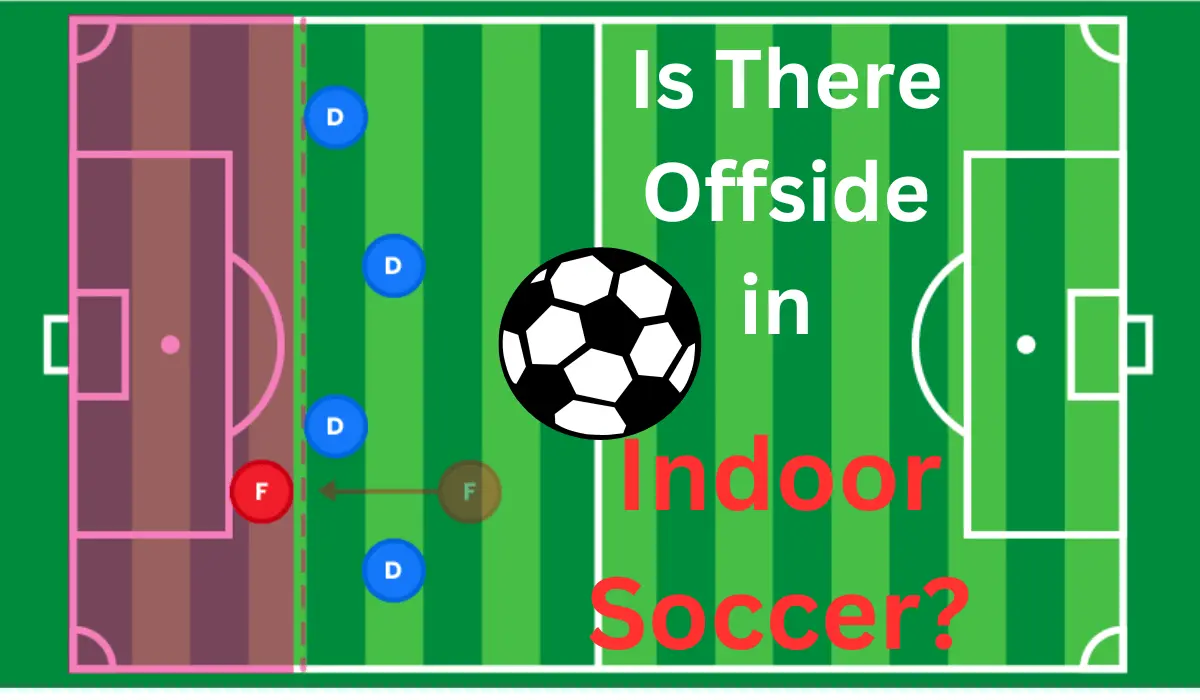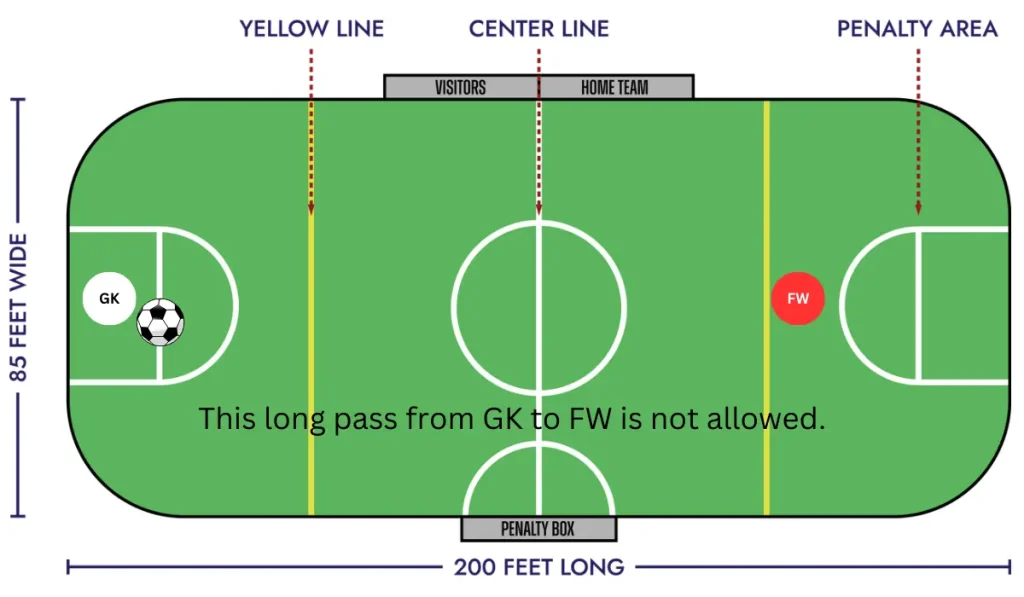Is There Offside in Indoor Soccer? No – Offside Rules

Forget the last-man panic!
Leave the offside flag-waving frustration behind!
Stepping onto the electrifying arena of indoor soccer is like entering a whole new dimension of the beautiful game.
Here, the pesky offside rule vanishes, replaced by a non-stop, goal-fest where walls become teammates and lightning-fast passes weave through space like magic.
That’s right, unlike its outdoor cousin, indoor soccer throws the offside trap out the window, unleashing a whirlwind of attacking freedom you won’t experience anywhere else.
But hold on, aspiring arena footballers! Just because Offside vanished doesn’t mean the battlefield is a free-for-all. Mastering this fast-paced, wall-hugging game takes more than just forgetting offside tactics.
We’ll dive into the playbook of this exhilarating sport, from penalty quirks to substitution secrets. We’ll learn how to exploit the walls and quick passes, outsmart your opponents, and rewrite the soccer playbook in this adrenaline-pumping wonderland.
So, shed the offside baggage, step onto the polished court, and embrace the freedom of the arena! This is your chance to become a master of the beautiful game’s indoor evolution.
Offside Rule in Indoor Soccer
The offside rule used in outdoor soccer does not apply to indoor soccer.
There is no offside rule in indoor soccer.
This allows attackers to position themselves close to the opponent’s goal without worrying about being called for an offside. Defenders need to be more alert as attackers can wait anywhere in the attacking half.
There are also players called thief players mostly adult indoor soccer players who’ll just hide during the whole game and then you’ll see them in front of the goal with the ball on their feet and nobody will be covering them so it is better to keep an eye on those players before the ball is passed to them.
However, to prevent players from making long aerial passes from their half directly into the opposition’s penalty area, indoor soccer uses the three-line violation rule.
What is the Three-Line Violation Rule?

The three-line violation rule prohibits players from making an aerial pass from behind their penalty area that crosses over all three lines into the opponent’s penalty area.
If a player makes such a long aerial pass, the referee will award an indirect free kick to the opposing team at the point where the ball crosses the first white line.
This rule prevents players from just playing speculative long balls over the top toward their forwards. It encourages building up play through short passes and individual skills.
The three-line violation adds an interesting tactical dimension.
Other Important Rules in Indoor Soccer
Apart from offside indoor soccer has many rules like unlimited substitutions, and different types of cards being used Also there is a straight red card on sliding tackles from behind.
So while there is no offside rule, other adapted indoor soccer rules, an evenly-matched contest of skills, speed, and strategy.
Indoor Soccer vs. Outdoor Soccer
Indoor and outdoor soccer share the same objective of scoring goals, but they differ significantly when it comes to field dimensions, number of players, game length, equipment, rules, and overall style of play.
Indoor soccer is played on a much smaller field with only 6 players per team compared to 11 in outdoor soccer. The compact arena with walls and smaller goals makes for a faster-paced game requiring quick passing and dribbling skills.
Indoor soccer games are just 60 minutes long with unlimited rolling substitutions, leading to almost non-stop end-to-end action.
Players wear the best shoes for indoor soccer having flat non-marking rubber outsole instead of cleats and kick the ball in rather than throw it when it goes out of the sidelines.
The no-offside rule allows attackers to freely roam into scoring areas in front of the opposite goal and to position themselves in scoring range means in the D area or adjacent to the D area. A unique indoor soccer blue card is used in indoor soccer to indicate a 2-minute penalty for small fouls.
The tighter spaces, faster pace, and increased reliance on individual ball skills give indoor soccer its feel compared to the outdoor game which relies more on team shape, set plays, and tactical formations.
While both versions share common elements, the variations in field, rules, and gameplay make indoor soccer an entirely different experience from its outdoor counterpart.
Player Positions and Formations in Indoor Soccer
One key difference between indoor and outdoor soccer is the positions and formations used due to having fewer players on the field. It’s normal to switch to unique indoor soccer positions and indoor soccer formations that develop in fast-paced games with no offside rule.
Defensive Positions
With no offside rule, defensive positioning becomes critical in indoor soccer. Defenders must slow down the offense while not allowing gaps between themselves and the goal. If beaten, they must recover quickly. Constant communication and coordination with teammates is essential.
Offensive Positions
Strikers in indoor soccer can position themselves more freely near the goal without worrying about being offside. Their focus is on making runs and scoring the goal, finding spaces to receive passes, and finishing scoring chances. Forwards must also be the first line of defense, pressing opponents.
Midfield Positions
Indoor soccer midfielders have a hugely important transition role going both ways between attack and defense. They need excellent close control and passing skills to retain possession in tight spaces. The midfielder must be very creative and confident on the ball so that he can deliver the best.
Interchanging Positions
There is greater fluidity in indoor soccer positions with players covering for each other. Attackers may have to defend and vice versa depending on match situations.
Adaptable Positions
The key is adapting positions and formations to your team’s strengths and weaknesses accordingly. With no offside rule, attackers have more freedom but defenders must be organized in a compact formation.
Having the tactical awareness and ability to play multiple positions allows your team to react to the fast-changing dynamics of indoor soccer driven by the no-offside rule and relentless end-to-end action with no room for mistakes because the intensity is very high a single mistake can cost in the form of a goal.
Key Skills Needed for Indoor Soccer
The unique playing conditions of indoor soccer require players to master some of the very common skills.
Indoor soccer improves a player’s close-quarters ball control, creativity, shooting, 1v1 skills, and off-the-ball movement – abilities that translate into being a better outdoor soccer player.
Conclusion
So, have we answered the burning question that sparked your entry into this article: “Is there offside in indoor soccer?”
Buckle up, because the answer is both a resounding “no” and a fascinating exploration of adaptation in the beautiful game.
While the dreaded offside trap doesn’t lurk in the shadows of the indoor arena, this absence isn’t a mere loophole. It’s a deliberate masterstroke, weaving its magic through modified rules like the three-line violation.
This clever rule prevents attackers from raining down long balls like hail, forcing them to unleash their artistry on the ground, weaving intricate passing triangles and showcasing deft close control.
But fear not, defenders! The lack of offside doesn’t leave you hanging like a lone goalkeeper against a Messi rocket. Indoor soccer throws in a curveball with five fouls per half, meaning careful tactics and smart challenges are as crucial as ever.
This unique blend of freedom and restriction creates a breathtaking tapestry of fast-paced action, where nimble footwork, lightning-fast passes, and pinpoint shooting reign supreme.
Ultimately, the absence of offside in indoor soccer isn’t just a missing rule; it’s a philosophical shift. It’s a celebration of individual skill, quick thinking, and constant communication within the confines of a compact arena.
It’s a playground for Messi-esque dribbles, Neymar-inspired flicks, and De Bruyne-level passing vision, all amplified by the walls playing the role of unexpected allies.
So, the next time you step onto the polished court, embrace the absence of the offside trap as a liberation, not a vacuum. Unleash your inner futsal maestro, hone your wall-hugging skills, and revel in the unique tactical dance that indoor soccer offers.
Remember, the question “Is there offside in indoor soccer?” isn’t just about a missing rule; it’s an invitation to a whole new dimension of the beautiful game, where the walls might just whisper the secrets to becoming a true arena master.
